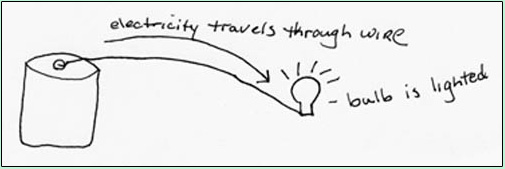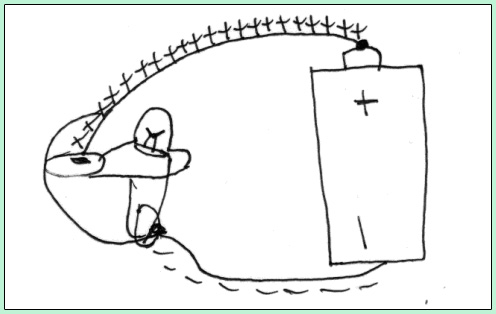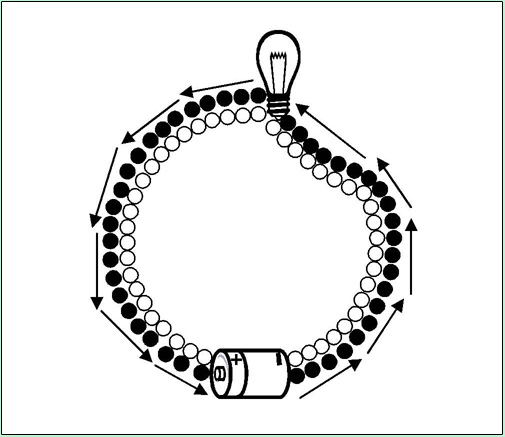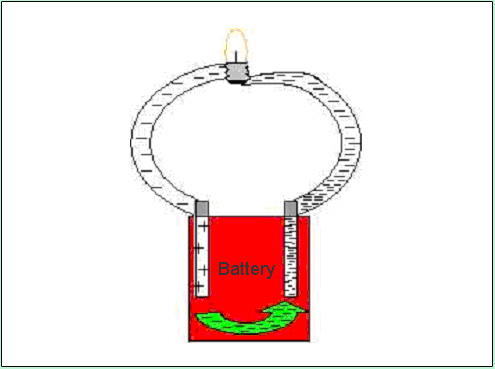Simple Circuits Curriculum
Introduction
Challenges in Understanding the Causality of Simple Circuits
Students typically have misconceptions about how simple circuits work.1 If you ask your students to draw a model to explain a simple circuit, you will probably notice the following things about their responses. Their models tend to be linear and sequential rather than systemic and simultaneous. (These terms and how they describe students' models are explained fully below.) Research shows that students' (and adults') understanding of simple circuits typically develops along a certain progression of models. It also shows that most people get stuck at the point where they need to reason about the circuit as a system2 and to visualize forms of causality that differ from our typical default assumptions about causes and effects. The most common misconceptions follow from these linear and sequential models. Once you figure out what models your students have, you hold the key to diagnosing their misconceptions and helping them towards greater understanding.
A Typical Progression of Students' Causal Models
Students' causal models usually progress from a Simple Linear Model, to a Double Linear Model, to a Cyclic Sequential Model.
Simple Linear Model
When given a battery, a bulb, and a wire and asked to light the bulb, students of all ages tend to begin by making the same kind of model. They join one part of the battery to one part of the bulb with the wire and show the "flow" of electricity going from the battery to the bulb.3 This is a Simple Linear Model (example below) where students expect one thing to make another thing happen in a domino-like pattern of effects. This model assumes that causes always closely and neatly precede effects (this is known as temporal priority), and that there is one cause and one effect.4
Students realize pretty quickly that this simple linear arrangement doesn't work to light the bulb. However, students find it very hard to give up this underlying Simple Linear Model. Even when students realize that they need another wire (or more specifically, a positive contact to the battery and a negative contact to the battery), they often argue that the "other wire is just a ground." A common related misconception is that the bulb "consumes" electrons.
Simple Linear Model

- Description
- A single wire running from the battery to the bulb "gives" electricity to the bulb. It is conceptually similar to what students think of when they see an electrical cord plugged into an outlet (if they don't realize that a cord has two wires or a circle of wires running inside it).
Characteristics
- There is a consumer-source relationship.
- Something goes from the battery to the bulb in a linear, unidirectional pattern.
Student Examples
- "The battery gives energy to the bulb."
- "The stuff from the battery flows up the wire and gives electricity to the bulb."
Double Linear Model
Students, especially those who understand how static electricity works, often modify their drawings to Double Linear Models (example below). These models retain the linear and sequential causality but typically show two paths. The paths may simply be additive (electricity flows up both sides) or they may have "attraction" or "clashing currents" aspects5 where students think that protons move up one wire and electrons move up the other wire to meet or clash in the bulb. Students may still envision electrical charge being consumed (therefore, they do not see charge as conserved) or going away by virtue of having lost its ionization. Unless challenged to think about it, students typically do not see an accumulation of electrons and protons in the bulb as problematic, even though this model predicts accumulation.
Double Linear Model

- Description
- Electricity is envisioned as traveling along wires from both terminals of the battery to fuel the bulb. It may be seen as additive (traveling up both sides so there is enough) or as having attraction aspects where protons go up one wire and electrons go up the other and meet in the bulb. Attraction versions are typically held by students who know about static electricity and know that protons and electrons are attracted to each other.
Characteristics
- Often involves a consumer-source relationship between the battery and the bulb.
- Something goes from the battery to the bulb in a linear, unidirectional pattern. It does something in the bulb to make it light (feeds it, attracts, clashes, cancels out).
- Students may draw Double Linear Models but consider one wire to be a "ground," or in some respects extra. Their underlying model is really a Simple Linear Model.
Student Examples
- "You need two wires to get enough power to make it light."
- "The electricity goes up both wires to make it light."
- "The electrons travel up one side and the protons travel up the other and they clash together to make it light."
- "Electrons from one side of the battery and protons from the other attract and meet in the bulb."
Cyclic Sequential Model
Through teaching, students typically progress next to a Cyclic Sequential Model (example below). Here, they view the circuit as initially empty and think of electrical current as a substance that fills the circuit and eventually reaches the bulb causing it to light. The current is envisioned as traveling from point to point and affecting each component in turn as it is encountered within the circuit.6 The electrical current or electrons continue on into the battery and are recycled. Students typically think that the current is used up so that there is less available to other components (such as bulbs) further along in the circuit. Students who hold this model often (erroneously) think that increasing the length of the wire will result in a noticeable increase in the length of time that it takes for the bulb to light.
The Cyclic Sequential Model is very common and it is particularly resistant to change. Even some students who have taken university courses and passed university level exams in physics still hold this model.7 Research shows that many classroom teachers, as well as students through the college level, reveal Cyclic Sequential Models. In order to get beyond this model, learners must shift their attention to the circuit as a system and think about what is happening simultaneously, rather than focus their attention on components of the circuit sequentially. This is challenging for many of us because it requires us to go beyond the simple linear and sequential causality that is typically our default for analyzing and understanding the world. This module includes a very simple computer program designed to help students see the difference between a Cyclic Sequential Model and a Cyclic Simultaneous Model of a simple circuit.
Cyclic Sequential Model

- Description
- The circuit is envisioned as initially empty and electricity or electrons begin to fill it, eventually reaching the bulb and causing it to light. The current is seen as traveling from point to point and affecting each component in turn. The electrical current or electrons continue on into the battery and are recycled to make the trip again.
Characteristics
- Electricity is seen as entering the circuit sequentially.
- Students tend to realize that some recycling is taking place. However, they also tend to think that some electricity is consumed. Therefore, they think that less electricity is available to components (such as light bulbs) that are further along in the circuit. Therefore, they predict that the first bulb in a series will be brightest and others will be progressively dimmer.
- Students expect a delay from the time that the wire is hooked up until electricity or electrons get to the bulb. They believe that the length of the delay increases with the length of the wire used. Other students believe that there will be no delay because electrons or electricity somehow can anticipate the length of the wire and speed up as necessary.
Student Examples
- "The electricity goes along the wire in a circle and when it gets to the bulb, the bulb lights up. Then it keeps going back into the battery and goes around again."
Beyond students' difficulties in understanding the more complex forms of causality, other related misconceptions reinforce erroneous Linear and Cyclic Sequential Models. For instance, students often view electricity as a substance to be consumed. This can be exacerbated by "water and hose" analogies unless the analogies are carefully analyzed. Students often believe that electrons are used up. Students may generally believe that if they see a bulb make light, something must have been used up to make it happen, just as gasoline is used up in a car to make it go. Therefore, it's important to present students with an alternative mechanism for why light is produced (resistance is involved) and to help them reconcile this mechanism with their competing explanation.8 To further complicate the problem, when students see an electrical cord, it looks like a simple linear path unless one looks carefully and notices that two wires are bound together.
Intermediate Causal Models
This curriculum introduces two intermediate causal models,9 a Cyclic Simultaneous Model and a Relational Causal Model, that serve as effective bridges for students in learning to understand simple circuits at the level of a system. The models draw students' attention to the circuit as a system. These two models fit better with scientifically accepted explanations (particularly an Electrical Potential Model) and have better explanatory power. Each of these models serves as an effective way for students to envision the circuit as a system and to reason effectively about Ohm's Law and parallel and series circuits. These models work with the kinds of models that scientists use (mathematical and constraint-based), but offer a way to picture what is going on.
Cyclic Simultaneous Model
In a Cyclic Simultaneous Model (example below), students learn that the wire is made of atoms made up of electrons (and protons and neutrons), and so there are electrons all along the wire prior to hooking the wire up. Electrons being repelled and repelling other electrons along the wire are the cause of the flow that causes the bulb to light.
What is the process that results in current flow? Picture the wire as made up of atoms (electrons, protons, and neutrons). Electrons are crowded or concentrated at the negative terminal of the battery. Because electrons repel other electrons, as soon as the wire is hooked up and the circuit is completed, electrons flow onto the wire (repelled by an excess of electrons at the negative terminal of the battery) in a path to the positive terminal (which has an excess of protons). As electrons flow along the wire, those electrons that are already along the wire begin moving. Each electron is repelled by the electron "behind" it and repels the electron "ahead" of it in the circuit. The protons don't move, just the electrons. As soon as there is flow, the filament heats up and the bulb lights. The electrons are conserved. The electrons go back into the battery at the positive contact where they are attracted to the excess of protons there. However, if electrons accumulated there, they would begin to repel the incoming electrons and stop the flow. The chemicals in the battery perform "work" by moving the electrons back to the negative pole of the battery and concentrating protons on one end of the battery and electrons on the other. The Cyclic Simultaneous Model has been compared to a bicycle chain where the whole circle turns at once. It is not possible for one component to move without the rest of it also moving.
This model helps students understand that current is shared between the components in the circuit. It necessitates attention to the entire system at once. The causality in the Cyclic Simultaneous Model is difficult to conceptualize because it requires thinking of effects as causes and causes as effects: electrons repel and are repelled at the same time. It also requires suspending the idea of temporal priority between causes and effects. They are simultaneous or near simultaneous. It is not as easily constructed from a Simple Linear Model as a Cyclic Sequential Model is. However, it is important for understanding the circuit as a system, and it offers an explanation of what happens along a simple circuit at the level of the particle. This serves as an important bridge to models that focus on electrical potential, a less zoomed-in level of analysis, where differences in electrical charge across the entire system enable electrical vibrations to propagate through the system.
Cyclic Simultaneous Model

- Description
- The Cyclic Simultaneous Model is an intermediate model designed as a bridge to more complex, scientifically accepted models. It forces students' attention to the circuit as a system. The wire is made up of atoms, so it already has electrons and protons all along it. They are balanced (meaning that there are equal numbers of electrons and protons). Once you hook up the battery and bulb, completing the circuit, electrons are repelled or pushed out of the battery on the negative side and attracted or pulled into the battery on the positive side. This makes the whole "circle of electrons" turn. At the particle level, each electron repels the electrons "ahead" of it on the wire and is repelled by those "behind" it. On the systematic level, the whole circle moves as one like a bicycle chain. Instead of one thing happening at a time, it happens all at once—it is simultaneous.10 The chemicals in the battery do the work of polarizing the protons and electrons to the plus and minus sides of the battery.
Characteristics
- There is no real beginning or end, at least not once electrons start flowing.
- Electrons act as causes and effects.
- Cause does not precede effect temporally.
- Cause of current flow is distributed.
- Cause at a local level (electrons repelling and being repelled by electrons) is linked with cause at a systematic level—the whole thing has to move at once like a bicycle chain.
Student Examples
- "The electrons are pushed by the electrons behind it and that makes them all move at once and makes the bulb light."
- "It's like a bicycle chain; the whole thing has to move at once."
- "All of the electrons are moving at once."
- "It doesn't go one at a time. It goes all at once."
Relational Model
The Relational Model (example below) underlies the scientifically accepted concept of electrical potential (sometimes called Electrical Potential or Electrical Differential Models). It focuses on differential and balance. An excess of electrons at the negative contact of the battery, and the relatively fewer electrons as well as the excess of protons at the positive contact, result in a differential so that the electrons flow away from areas of higher concentration to areas of lower concentration of electrons. The chemicals in the battery perform "work" by concentrating net protons on one end of the battery and net electrons on the other. This is work because the protons and electrons are attracted to each other, and creating an excess of electrons (which repel each other) and protons (which repel each other) requires energy. The excess of electrons at the negative contact and the depletion of electrons at the positive contact, as well as the excess of protons, create a differential so that the electrons flow away along the circuit path from the area of higher concentration to the area of lower concentration of electrons.
The concept of electrical potential involves relational causal reasoning, where students need to think about the relationship between two variables as the cause of an outcome rather than one variable or one event as the cause. This form of causality departs significantly from linear or additive forms of causality. The Relational Model helps students understand why electrical impulses propagate along the wire and offers an important segue into thinking about the circuit using Ohm's Law and the constraints of voltage, resistance, and ultimately current. It takes into account the entire system and how different variables impact it.
Relational Model

- Description
- The concept of electrical potential requires students to see the circuit in terms of a differential. This involves a Relational Model. The battery performs work by creating an imbalance in the concentration of electrons between the positive and negative terminals. The higher the voltage of the battery, the more the battery is able to push electrons away from the protons that they are attracted to, and towards electrons that they are repelled from. Therefore, the more voltage, the more electrons the battery can concentrate on the negative terminal. In this model, the cause of flow is visualized in terms of the relationship between areas of greater and lesser density (or crowding). Electrons move from areas of higher concentration to areas of lower concentration, therefore, as the wire is hooked up, they move onto the wire where there is a lower concentration and move along it as the battery works to concentrate more electrons on the negative terminal.
Characteristics
- The outcome is caused by the different concentrations of electrons throughout the system.
- Neither "status" (high concentration or low concentration) is the cause by itself. Flow is caused by the relationship of imbalance—having areas with greater and lower concentration.
- The model forces us to think about flow at a systematic level.
Student Examples
- "The imbalance between electrons on the negative contact of the battery and the positive contact, makes the electrons move to where there are less electrons and so they flow continually around the circuit."
The Connection Between Current Flow and the Bulb Lighting
Why does the bulb light when there is current flow? Characteristics of the wire inside the bulb (known as the filament) make it difficult for electrons to move along it. Impeding the flow of electrons results in energy transfer that heats the filament, which becomes hot enough to glow and give off light. One way to help students move beyond the notion, that in order to produce light something must be used up, is to consider the analogy of a water wheel. In a water wheel there is turning without using something up. However, the concept is even more complex than the analogy accounts for. Eventually, the link must be made between flow and the creation of light and heat11 (as explained in the background notes to Lesson 4).
Helping Your Students Achieve Deeper Understanding
The activities in this module are designed to reveal your students' current causal models, and to help them progress towards models that have greater explanatory power. It is likely that your students' ideas will fall along a continuum of the models presented in these lessons and that they will hold many of the misconceptions related to the particular model. Some students may hold a combination of models or idiosyncratic versions of these or other models. However, a wealth of research suggests that these models outline the kinds of ideas your students bring to their learning.
It is important to note that the kinds of models presented here are conceptual models. They are not the same as the schematic diagrams that electricians draw to illustrate different kinds of circuit configurations and that some science curriculums attempt to teach. The models here attempt to illuminate why circuits work, to the extent of our scientific understanding and at a level that provides effective models from which middle school students can reason.


